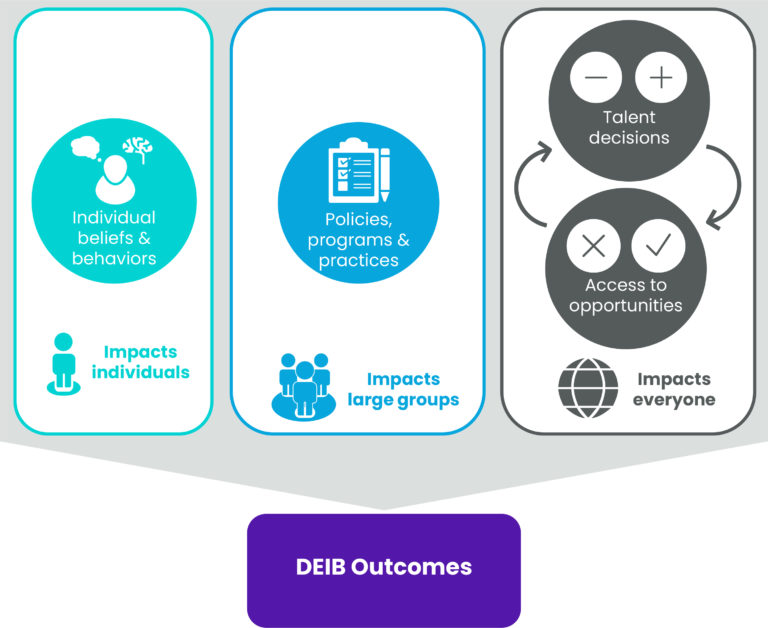We all know that diversity, equity, inclusion and belonging (DEIB) have been much higher on C-suite, board and CHRO agendas than ever before. The question for many, though, is how to integrate inclusion to drive results? Historically, organizations have taken a programmatic approach of offering training on diversity-related topics, such as unconscious bias, in the hopes of addressing DEIB challenges. Unfortunately, diversity programs tend to fail.
So, what should leaders do instead?
Our research shows leaders should think systemically, not individually, about DEIB. This means shifting their mindset from “the challenge with DEIB is individuals (who need diversity training)” to “the opportunity of DEIB is in adjusting our daily processes and practices so they better fit the needs of all.”
The latter mindset has several benefits:
- It scales across the organization and is not limited to the good (or bad) behavior of individuals.
- It gives everyone in the organization an opportunity to own improving DEIB in the organization.
- It forces orgs to focus on equity and access for all as opposed to focusing just on diverse individuals, which can have negative repercussions.
- It creates the conditions that make it easy to support all (similar to how routines and habits have the power to revolutionize our daily lives).
See also: Want real HR change? Look to data and analytics

Author Stacia Garr
Research has shown that, when organizational systems are designed intentionally to both serve business needs and to encourage DEIB, both can occur. For example, one study published in Harvard Business Review found multiple benefits of management trainee programs: They allowed the trainees to try new jobs and learn about the company and they exposed department heads and trainees to a wider diversity of people. The researchers found that, when organizations deploy such programs, they see an increase of 3% to 7% in white women, Black men and women, and Asian-American men and women in management.
What is HR’s responsibility?
HR is responsible for several levers that impact DEIB outcomes, specifically:
- Policies, programs, and practices
- Talent decisions
- Access to opportunities
Through those levers, HR influences the behaviors of individuals and groups, and thus DEIB outcomes and the overall culture (see figure below). Levers That Drive DEIB Outcomes

Therefore, HR’s opportunity is to integrate inclusion into all of those levers.
How might an organization do this?
This is exactly what we explored in our recent podcast season, Integrating Inclusion, and will be discussing in our upcoming webcast, summarizing our learnings from the season. In short, it means that HR looks at all of those levers through a DEIB lens, and asks questions such as:
- To what extent are employees from historically disadvantaged populations participating in this program/process at the rates we would expect, given their representation levels?
- To what extent and in what ways are the existing policies/practices/programs unintentionally negatively impacting our historically disadvantaged populations?
- In what ways have we integrated a focus on DEIB into our existing programs, especially as they impact talent decisions and access to opportunities?

Related: How to use HR tech for an integrated DEI approach
Here are some of the workplace stories we heard in our podcast that show how orgs are doing this:
- Analyzing succession categories: One organization analyzed had succession lists of “ready in one year,” “ready in two years” and “ready in three-plus years.” When the company analyzed the categories by diversity characteristics, they found opportunities to improve the process for employees in the longer-term categories. When they compared all leaders’ categories with their independent, data-driven leadership assessment, they saw discrepancies—specifically, they found little correlation between the leadership assessment categories and the succession buckets. The insights revealed that the different year-ready buckets could be improved in certain ways. For example, the company decided to create a pool of “ready-now” leaders and “ready-next” leaders, which reflected the data-based leadership capabilities assessment. This distinction resulted in an increase in the number of diverse candidates in their “ready-now” succession pool.
- Rethinking layoffs: Another organization, which had to lay off employees during COVID, insisted on its core value of belonging throughout the entire process of reduction in force. While that might seem like a misnomer, this organization gave employees the time and space to say goodbye to their peers and to feel like their talent and contributions were honored. The organization gave people time to finish up their work, orchestrating moments where people’s work was celebrated, and leaders had individual conversations with all of them. The company then hosted the profiles of the people who were laid off on their recruiting website, turning their recruiting team to face outward and help place people in organizations directly.
- Integrating DEIB discussions into leadership development: Yet another organization developed a leadership development program called “Create,” which includes coaching circles. These circles are led by internal coaches, who lead the groups of no more than seven people through relevant conversations. Recently, they have focused on DEIB in these circles, with the vision that leaders need a group to have open and deep conversations about DEIB—and then feel prepared to talk about it with their teams.
All of these organizations focused on this systemic, integrated approach to DEIB—not just launching individual programs or policies. As one of our podcast guests put it:
“You have to take a systemic approach … You can’t just teach somebody how to recognize a microaggression or how to recognize unconscious bias/make it conscious. Of course, those are important skills, but you need the frame, you need the whole holding environment to make it work.” —Dr. Rachel Fichter, global head of talent and leadership, S&P Global
How can I get started?
We’ve developed a six-step model to align DEIB efforts, and the very first step is to figure out why your organization is focusing on DEIB. It is important to get your company’s “why” right, as it influences all the other decisions you make about practices, policies, programs, talent decisions and opportunities.
In our webinar on Oct. 27, we will discuss in more detail how organizations can get started, as well as the many wonderful stories we hard on the Integrating Inclusion podcast series. We welcome you to join us or reach out to us at hello@redthreadresearch.com!